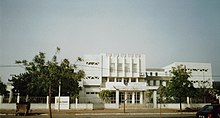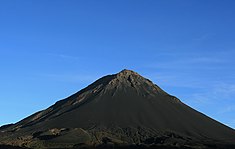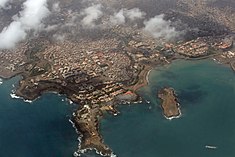The Republic of Cape Verde (i /ˌkeɪp ˈvɜrd/; Portuguese: Cabo Verde,
pronounced [ˈkabu ˈveɾd]; Kabuverdianu: Kabu Verd) is an island country,
spanning an archipelago of 10 islands located in the central Atlantic
Ocean, 570 kilometres off the coast of Western Africa. The islands,
covering a combined area of slightly over 4,000 square kilometres (1,500
sq mi), are of volcanic origin and while three of them (Sal, Boa Vista
and Maio) are fairly flat, sandy and dry, the remaining ones are
generally rockier and have more vegetation. Because of the infrequent
occurrence of rainfall the overall landscape is not particularly green,
despite what the country's name suggests (verde is Portuguese for
"green"). The name of the country stems instead from the nearby Cap
Vert, on the Senegalese coast.
The previously uninhabited islands
were discovered and colonized by the Portuguese in the 15th Century, and
became an important location in the Atlantic slave trade due to their
geographically advantageous position. The islands' prosperity often
attracted pirates including Sir Francis Drake, who twice sacked the
(then) capital Ribeira Grande, in the 1580s. The islands were also
visited by Charles Darwin's expedition in 1832. The decline in the slave
trade in the 19th century resulted in an economic crisis. With few
natural resources and without strong sustainable investment from the
Portuguese, the people grew increasingly discontent with the colonial
masters, who nevertheless refused to provide the local authorities with
more autonomy. This discontent festered and culminated in 1975, when a
movement led by Amílcar Cabral achieved independence for the
archipelago.
The country has an estimated population (most of it
of creole ethnicity) of about 500,000, with its capital city Praia
accounting for a quarter of its citizens. Nearly 38% of the population
lives in rural areas according to the 2010 Cape Verdean census; about
20% lives below the poverty threshold,and the literacy rate is around
85%. Politically, the country is a very stable democracy, with notable
economic growth and improvements of living conditions despite its lack
of natural resources, and has garnered international recognition by
other countries and international organizations, which often provide
development aid. Since 2007, Cape Verde has been classified as a
developing nation.
Tough economic times during the last decades of
its colonization and the first years of Cape Verde's independence led
many to migrate to Europe, the Americas and other African countries.
This migration was so significant that the number of Cape Verdeans and
their descendants living abroad currently exceeds the population of Cape
Verde itself. Historically, the influx of remittances from these
immigrant communities to their families has provided a substantial
contribution to help strengthen the country's economy. Currently, the
Cape Verdean economy is mostly service-oriented with a growing focus on
tourism and foreign investment, which benefits from the islands' warm
climate throughout the year, diverse landscape, welcoming people and
cultural richness, especially in music.
Geography
Magnetic anomalies identified in the vicinity of the archipelago
indicate that the structures forming the islands date back 125-150
million years: the islands themselves date from 8 million (in the west)
to 20 million years (in the east).The oldest exposed rocks occurred on
Maio and northern peninsula of Santiago and are 128-131 million year old
pillow lavas. The first stage of volcanism in the islands began in the
early Miocene, and reached its peak at the end of this period, when the
islands reached their maximum sizes. Historical volcanism (within human
settlement) has been restricted to the island of Fogo.
The origin
of the islands' volcanism has been attributed to a hotspot, associated
with bathymetric swell that formed the Cape Verde Rise. The Rise is one
of the largest protuberances in the world's oceans, rising 2.2
kilometers in a semi-circular region of 1200 km², associated with a rise
of the geoid and elevated surface heat flow.
Most
recently erupting in 1995, Pico do Fogo is the largest active volcano
in the region. It has a 8 km (5 mi) diameter caldera, whose rim is 1,600
m (5,249 ft) altitude and an interior cone that rises to 2,829 m (9,281
ft) above sea level. The caldera resulted from subsidence, following
the partial evacuation (eruption) of the magma chamber, along a
cylindrical column from within magma chamber (at a depth of 8 km (5
mi)).
Geologically, the islands are principally composed of
igneous rocks, with volcanic structures and pyroclastic debris
comprising the majority of the archipelago's total volume. The volcanic
and plutonic rocks are distinctly basic; the archipelago is a
soda-alkaline petrographic province, with a petrologic succession which
is similar to that found in other Macaronesian islands.
Climate
Cape Verde's climate is milder than that of the African mainland
because the surrounding sea moderates temperatures on the islands.
Average daily high temperatures range from 25 °C (77 °F) in January to
29 °C (84.2 °F) in September. Cape Verde is part of the Sahelian arid
belt, with nothing like the rainfall levels of nearby West Africa. It
does rain irregularly between August and October, with frequent
brief-but-heavy downpours.A desert is usually defined as terrain which
receives less than 250 mm (9.8 in) of annual rainfall. Cape Verde's
total (261 mm/10.3 in) is slightly above this criterion, which makes the
area climate semi-desert.
Hurricanes that form near the Cape
Verde Islands are sometimes referred to as Cape Verde-type hurricanes.
These hurricanes can become very intense as they cross warm Atlantic
waters.
Biome
Cape Verde's isolation has resulted in the islands having a number of
endemic species, particularly bird and reptiles, many of which are
endangered by human development. Endemic birds include Alexander's Swift
(Apus alexandri), Bourne's Heron (Ardea purpurea bournei), the Raso
Lark (Alauda razae), the Cape Verde Warbler (Acrocephalus brevipennis),
and the Iago Sparrow (Passer iagoensis).The islands are also an
important breeding area for seabirds including the Cape Verde
Shearwater. Reptiles include the Cape Verde Giant Gecko (Tarentola
gigas).
Demographics
Most of the population is of creole ethnicity, mixed from black
African and European descent. The European men who colonized Cape Verde
did not usually bring wives or families with them. As female African
slaves were brought to the islands inter-marriages occurred.
Around
95% of the population is Christian (more than 85 percent of the
population is nominally Roman Catholic, though for a minority of the
population Catholicism is syncretized with African influences)The
largest Protestant denomination is the Church of the Nazarene; other
groups include the Seventh-day Adventist Church, the Church of Jesus
Christ of Latter-day Saints, the Assemblies of God, the Universal Church
of the Kingdom of God, and various other Pentecostal and evangelical
groups.)There are small Baha'i communities and a small Muslim community.
The number of atheists is estimated at less than 1 percent of the
population.
Cape Verde's official language is Portuguese. It is
the language of instruction and government. However, the Cape Verdean
Creole is used colloquially and is the mother tongue of virtually all
Cape Verdeans. Cape Verdean Creole or Kriolu is a dialect continuum of a
Portuguese-based creole, which varies from island to island. There is a
substantial body of literature in Creole, especially in the Santiago
Creole and the São Vicente Creole. Creole has been gaining prestige
since the nation's independence from Portugal. However, the differences
between the varied forms of the language within the islands have been a
major obstacle in the way of standardization of the language. Some
people have advocated the development of two standards: a North
(Barlavento) standard, centered on the São Vicente Creole, and a South
(Sotavento) standard, centered on the Santiago Creole. Manuel Veiga,
PhD, a linguist by training, and Minister of Culture of Cape Verde, is
the premier proponent of Kriolu's officialization and standardization.
The demographic statistics site ESA says Cape Verde has a population of
567,000 in 2010.
Tourism
Cape Verde's strategic location at the crossroads
of mid-Atlantic air and sea lanes has been enhanced by significant
improvements at Mindelo's harbor (Porto Grande) and at Sal's and Praia's
international airports. A new international airport was opened in Boa
Vista in December 2007, and on the island of Sao Vicente, the newest
international airport (Sao Pedro Airport) in Cape Verde, was opened in
late 2009. Ship repair facilities at Mindelo were opened in 1983. The
major ports are Mindelo and Praia, but all other islands have smaller
port facilities. In addition to the international airport on Sal,
airports have been built on all of the inhabited islands. All but the
airport on Brava enjoy scheduled air service. The archipelago has 3,050
km (1,895 mi) of roads, of which 1,010 km (628 mi) are paved, most using
cobblestone.
The country's future economic prospects depend
heavily on the maintenance of aid flows, the encouragement of tourism,
remittances, outsourcing labor to neighboring African countries, and the
momentum of the government's development program.
Tourism has
increased in recent years. Large hotels have been built across the
country in an effort to boost tourism. In particular, on the islands of
Boa Vista (Club Hotel Riu Karamboa (750 rooms)), and Sal (Club Hotel Riu
Funana/Garopa (1000 rooms)--the largest hotel in all of West Africa).
The Cape Verde islands have a relatively low crime rate and beautiful
beaches, as well as having engaging local people. Tourists and leisure
seekers from across Europe and the world are coming to the country in
larger numbers.
Education

Primary school education in Cape Verde is
mandatory between the ages of 6 and 14 years and free for children ages 6
to 12.In 2008, the net enrollment ratio for primary school was
84%.While enrollment rates indicate a level of commitment to education,
they do not always reflect children's participation in school.Textbooks
have been made available to 90 percent of school children, and 83
percent of the teachers have attended in-service teacher training.
Although most children have access to education, some problems remain.
For example, many students and some teachers speak Creole at home and
have a poor command of Portuguese (the language of instruction); there
is insufficient spending on school materials, lunches, and books; and
there is a high repetition rate for certain grades.
Miss Cape Verde 2012:
















No comments:
Post a Comment